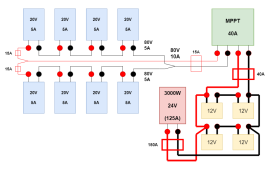I'm planning to setup a smaller 800W off-grid solar panel system for my weekend cottage in Western Europe.
I already bought the necessary parts, cables, and accessories, here's my design sketch for this off-grid solar panel system:

I already bought the necessary parts, cables, and accessories, here's my design sketch for this off-grid solar panel system:

Parts:
- Batteries: 4x 120Ah 12V BIG Professional Solar DC
- Solar Panels: 8x 100W 12V Renogy Monocrystalline (compact design version)
- Charge Controller: EPEVER Triron 4215N 40A 150V MPPT 12/24VDC + EPEVER MT50 Remote Control
- Inverter: Novopal 3000W 24V Pure Sine Voltage Converter
- 1x 150A ANL Fuse (between the battery bank and the inverter)
- 2x 15A Inline Solar Panel Fuse (for the 2 clusters of 400W solar panels)
- 1x 15A 500V DC Curcuit Breaker (between the solar panels and the charge controller)
- 1x 40A 500V DC Curcuit Breaker (between the charge controller and the battery bank)
- necessary Y plugs, 2x 10m of standard 10AWG (6mm2) solar cable extension cords and thick 3/0AWG (95mm2) cables for the batteries and the inverter
Short Plan Summary:
- 1.: connect the 4 batteries in series AND parallel getting 24V of 240Ah
- 2.: connect this battery bank with the 3000W 24V inverter, there's a 150A ANL fuse between the inverter and the battery bank
- 3.: connect the EPEVER charge controller with the battery bank, there's a 40A 500V DC circuit breaker between them
- 4.: create 2 clusters of 400W solar panels in series (20V 5A => 80V 5A), then connect these 2 clusters with 15A inline fuses, thus getting the 800W solar panel array (2x 80V 5A => 80V 10A) - the EPEVER charge controller can handle only 150V Max PV
- 5.: connect the solar panel array to the charge controller, there's a 15A 500V DC circuit breaker between the solar array and the charge controller
Questions:
- 1.: As the EPEVER charge controller can handle only 150V Max PV, the solar panel array consists of 2 clusters of 400W solar panels in series, then connect them in parallel. Is this a correct way to connect these 8x 100W solar panels to my EPEVER charge controller in my case?
- 2.: Are the 15A inline fuses, the 15A, and 40A circuit breakers, and also the 150A ANL fuse correct/applicable for this system?
- 3.: When the solar system is fully connected, is there a recommendation for where to connect the inverter to the battery bank to? Connect closest to the charge controller (i.e.: connect the inverter cable directly to the battery tab/terminal/bushing where the charge controller connected too), or farthest from the charge controller connection (i.e.: connect the inverter cable essentially the opposite/farthest battery tabs/terminals/bushings)


